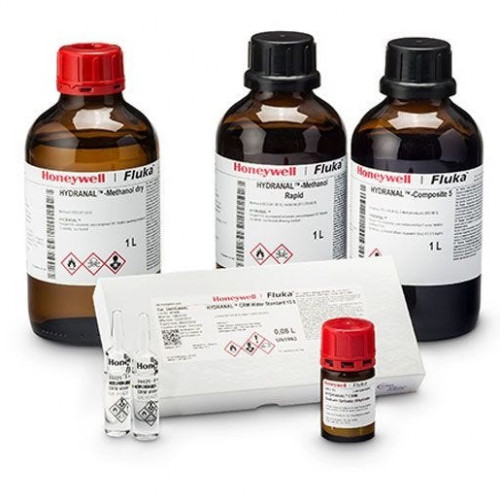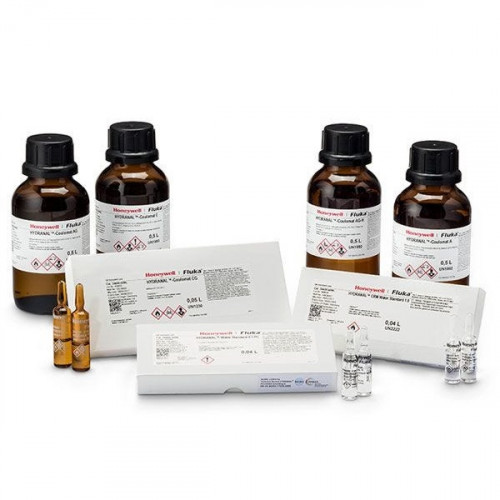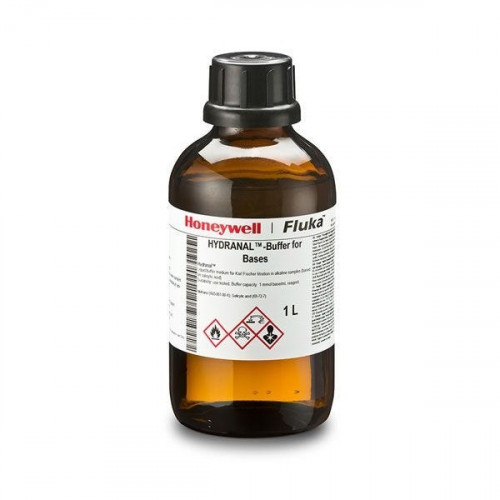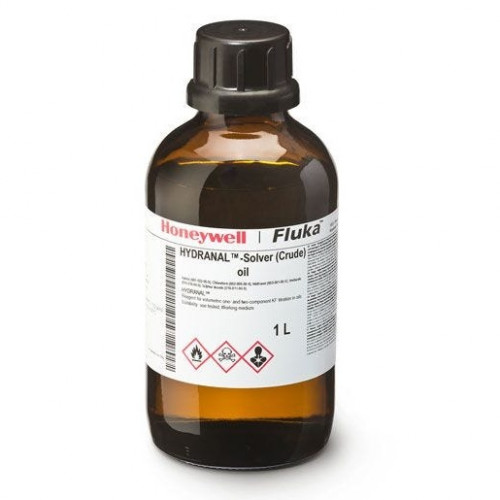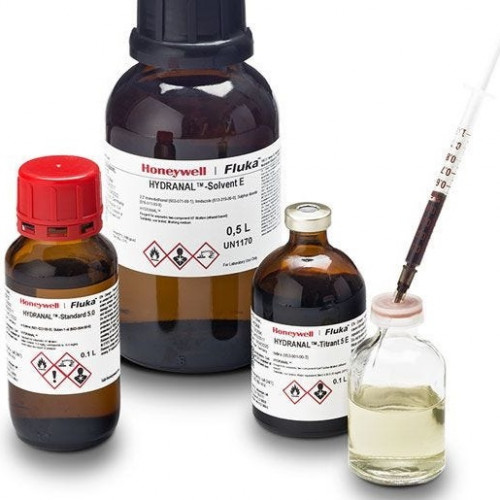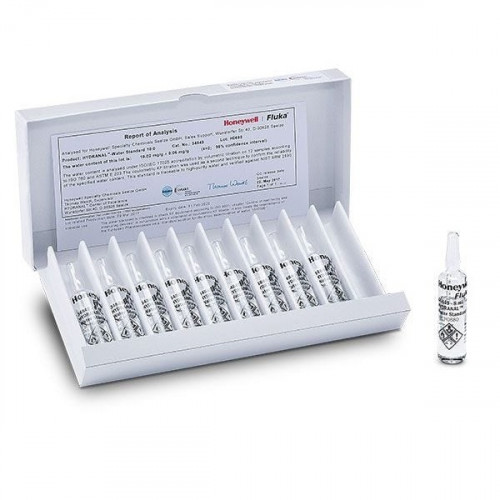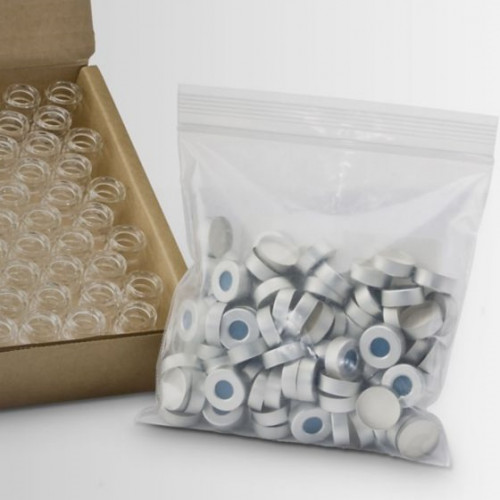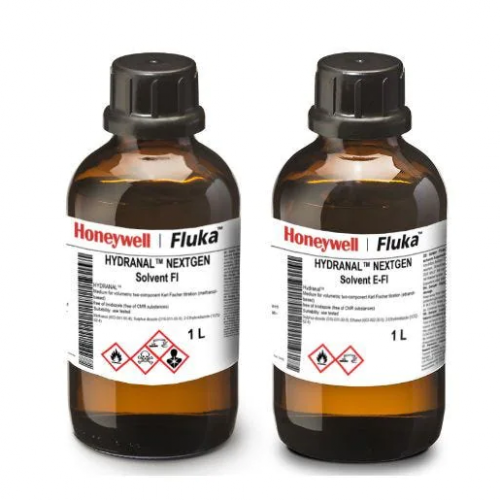-
{{ cart_product.name }}
{{ Number(cart_product.price*cart_product.quantity).toLocaleString() }} UAH ×
HYDRANAL™
HYDRANAL™ History
The original Hydranal™ KF reagents have been produced for over 35 years in Seelze, Germany. Since 1979 our Hydranal Center of Excellence has introduced 57 Hydranal reagents and secured 50 patents. Our dedication to R&D in the area of water determination by KF titration gives us the broadest and most advanced KF reagent portfolio available.
Our premium Hydranal reagents are manufactured to strict standards in production and quality control. Continuous innovation at our Center of Excellence in Seelze delivers new products that enhance the safety and efficacy of our products in your laboratories.
We are proud of our heritage and the exceptional quality of our products.
Timeline
|
1935 |
Karl Fischer published a reagent for water determination consisting of iodine, sulfur dioxide, pyridine and methanol |
|
1979 |
Eugen Scholz and Helga Hoffmann (Riedel-de Haën™) replaced pyridine by imidazole and invented Hydranal reagents |
|
1980 |
First pyridine-free Hydranal reagents were launched: |
|
1981 |
First coulometric reagents, Hydranal-Coulomat A and Hydranal-Coulomat C, were developed |
|
1981 |
Hydranal-Buffer Acid, buffering medium for acidic samples, was introduced |
|
1983 |
Special methanol-free volumetric reagents for the determination of water in aldehydes and ketones, Hydranal-Composite 5 K and Hydranal-Working Medium K, were introduced |
|
1984 |
Special methanol-free coulometric reagents for the determination of water in aldehydes and ketones, Hydranal-Coulomat AK and Hydranal-Coulomat CG-K, were introduced |
|
1984 |
Hydranal -Standard 5.0, first water standard for KF titration, was introduced |
|
1986 |
Diethanolamine in two-component reagent was changed to imidazole |
|
1987 |
Hydranal -Water Standard 1.0, first water standard in ampoules, was introduced |
|
1991 |
A new set of coulometric reagents free of halogenated hydrocarbons was introduced |
|
1993 |
A new set of water standards was introduced: Hydranal-Water Standard 0.1, Hydranal-Water Standard 10.0 and Hydranal-Standard Sodium Tartrate Dihydrate |
|
1996 |
Hydranal-Water Standard Oven KF 220-230°C was introduced |
|
1997 |
Hydranal-Ketosolver, medium free of halogenated hydrocarbons for the determination of water in aldehydes and ketones, was introduced |
|
1998 |
First ethanol-based KF reagents, the Hydranal E-types, were introduced |
|
1998 |
KF reagents for back titrations were developed |
|
1999 |
Hydranal-Buffer Base, buffering medium for basic samples, was introduced |
|
2003 |
Hydranal-Medium K, less toxic medium for the determination of water in aldehydes and ketones, was introduced |
|
2007 |
Hydranal-Water Standard KF Oven 140-160°C was introduced |
|
2007 |
Hydranal-Water Standard Oil, water standard based on mineral oil with very low (< 50 ppm) water content, was introduced |
|
2008 |
Hydranal reagents brand changed from Riedel-de Haën to Fluka |
|
2009 |
Hydranal Laboratory obtained accreditation according to ISO/IEC 17025 |
|
2014 |
Hydranal Laboratory obtained accreditation according to ISO/IEC 17025 and ISO 17034. Hydranal CRM Water Standards were developed |
|
2014 |
Hydranal Water Standard 0.1 PC with improved stability was introduced |
|
2015 |
Hydranal became part of Honeywell family |
|
2017 |
Hydranal CRM Water Standards were launched |
Guaranteed Highest Level of Quality
The Hydranal Center of Excellence has secured the accreditation as test laboratory according to ISO/IEC 17025 and the accreditation as reference material manufacturer according to ISO 17034. With this double accreditation, we are part of a select group of laboratories worldwide that can guarantee the highest level of certified quality.
Improving the Classic Method
A defined, reliable and truly practical method for water measurement was introduced in 1935 when chemist Karl Fischer published his manuscript “New procedure for the determination of the water content in liquids and solids.” (K. Fischer; Angew. Chemie 1935, 48, 394).
Karl Fischer titration, or KF titration, could be employed to determine the water content of substances. His titration technique was one of the most frequently used methods in analytical chemistry until 1979, when improvements were discovered.
Chemists at Riedel-de Haën in the late 1970s developed ways to improve the standard original KF titration. The changes they introduced in 1979 improved safety, accuracy and ease of use, in addition to widening the substrates where it is applied. These improvements became the foundation of the Hydranal product line.
Three important innovations
1. Noxious pyridine is replaced by bases that are both safer and more effective.
2. New reagents and techniques reduce the number of required components, make end points clearer and more stable, giving faster and more sensitive reactions.
3. Removal of halogenated hydrocarbons and methanol improved safety and shelf life of reagents.
New Hydranal KF Titration Reagents
The first two-component reagent containing diethanolamine as the base, Hydranal-Solvent and Hydranal-Titrant, was introduced in 1980. This reagent allows a rapid titration with a stable end point. The base of this reagent was changed to imidazole in 1986 to further improve capacity.
Hydranal-Composite, a one-component reagent that contains imidazole as the base, was introduced to the market in 1980. In later years the coulometric reagents Hydranal-Coulomat A, and Hydranal-Coulomat C followed and enabled the coulometric technique for water determination. In 1991 a new set of coulometric reagents free of halogenated hydrocarbons was introduced.
Next were introduced special methanol-free reagents for the determination of water in aldehydes and ketones, Hydranal-K reagents. This product line comprises the Hydranal-Composite 5 K, and Hydranal-Medium K for the volumetric determination of water and Hydranal-Coulomat AK, and Hydranal-Coulomat CG-K for coulometric determination.
A further milestone was the introduction of the Hydranal-Water Standards and CRM Hydranal water standards with exactly defined water content.
The range of KF titration reagents also includes Hydranal T-type reagents based on Ethanol, reagents for back titrations, buffering substances and Trockenmittel.
Research into additional reagents that will be less harmful to health and environment is ongoing.
ISO Accreditation
For more than 35 years, the Hydranal™ laboratory, based in Seelze, Germany, has applied some of the highest standards in production and quality control for the Karl Fischer (KF) reagents and water standards product line.
In 2009, through our stringent testing capabilities, we obtained ISO/IEC 17025 accreditation. Later in 2014, the Hydranal lab was audited by DAkkS (Germany’s national accreditation body) and received accreditation as a certified reference material (CRM) producer under ISO 17034. With this accreditation we join a select group of organizations and companies worldwide that are working at the highest levels of certified quality.

